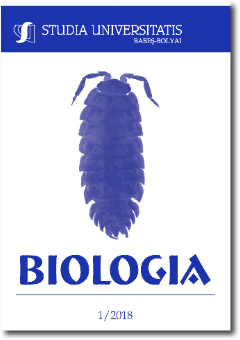Antibiotic susceptibility of bacterial isolates and water quality index of water sourced from closed ground water and open hand dug well in Koko Community, Delta State, Nigeria
DOI:
https://doi.org/10.24193/subbbiol.2018.1.04Keywords:
antibiotic susceptibility, ground water, hand dug wells, microbio¬logical analysis, water quality.Abstract
Water samples were collected from a semi urban community in Nigeria with the aim of investigating the water quality index and antibiotic profile of bacterial isolates of closed ground water and open hand dug wells. Physicochemical and microbiological analyses were carried out using standard analytical methods. pH of groundwater and hand dug well ranged from 4.16 to 5.74 and 4.83 to 5.22 respectively. The total suspended solid of water samples for hand dug well ranged from 1.2-9.2mg/l. Also iron concentrations for groundwater and hand dug well water samples ranged from 0.15-0.54 mg/l and 0.62-1.12 mg/l respectively. Microbial analysis of the water samples revealed the presence of bacteria such as S. aureus, Klebsiella sp., E. coli, B. subtilis, Pseudomonas, Aeromonas hydrophila and Enterobacter aerogenes and fungi such as Aspergillus niger, Penicillium notatum, Aspergillus flavus, Rhizopus stolonifer and Saccharomyces cerevisiae. The total heterotrophic bacterial count of water samples for groundwater and hand dug well samples indicated that values ranged from 2.9 - 4.4 ×103 cfu/ml and 5.4 – 8.6 ×103 cfu/ml respectively. Total coliform of water samples for groundwater and hand dug well samples indicated that values ranged from 5-8 MPN/100ml and 10-20 MPN/100ml respectively. E. coli count of water samples for groundwater and hand dug well samples indicated that values ranged from 0.0 MPN/100ml and 4-8 MPN/100ml respectively while total fungal count of groundwater and hand dug well samples indicated that values ranged from 0.0 - 6.0×102 cfu/ml and 3.5×102-17.0×103 cfu/ml respectively. Variable antibiotic susceptibility patterns were observed in antibiotic inhibitory zone (mm) among the tested bacterial isolates. Evaluation of Water Quality Index indicated values of 34.4 for groundwater source indicating good water quality and 67.31 for open hand dug well indicating water was of poor quality. Findings from this study revealed that groundwater sources had better and acceptable quality compared to those of open hand dug wells, hence it is recommended that critical measures be put in place to ensure the safety of both sources of water in Koko community.
References
Adekunle, L. V., Sridhar, M. K., Ajayi, A. A., Oluwale, P. A., Olawuyi, J. F. (2004) An assessment of health and socio-economic implications of sachet in Ibadan, Nigeria: A Public Health Challenge. African Journal of Biomedical Research 7(1): 5–8
Ademoroti, C. M. A. (1996) Standard Methods for Water and Effluent Analysis. Foludex Press. Ltd. Ibadan, 182 pp.
Agbaire, P. O., Obi, C. G. (2009) Seasonal variations of some physico-chemical properties of River Ethiope Water in Abraka, Nigeria. Journal of Applied Science and Environmental Management 13(1): 55-57
American Public Health Authority (APHA) (1993) Standard Methods for Examination of Water and Wastewater.18th Edn.APHA.Washington D.C. 1421 pp.
Ashaye, O. A., Couple, A. A., Afolabi, O. O., Fasoyiro, S. B. (2001) Physicochemical properties of pure water samples in South Western, Nigeria. Journal of Food Technology 6(4): 119–120
Barnett, H. L., Hunter, B. B. (1972) Illustrated Genera of Imperfect Fungi. 3rd edn. Burgess Publishing Co. New York, 225 pp.
Chatterjee, C., Raziuddin, M. (2002) Determination of water quality index of a degraded river in Asanol industrial area, Raniganj, Burdwan, West Bengal. Nature, Environment and Pollution Technology 1(2): 181-189
Cheesebrough, M. (2006) District Laboratory Practice in Tropical Countries. Cambridge University Press. London, 434 pp.
Harley, J.P. and Prescott, L.M. (2002). Laboratory Exercises in Microbiology. 5th Edn. Mac Graw Hill, New York, 449 pp.
Imarhiagbe, E. E, Obayagbona, O. N, Osarenotor, O., Eghomwanre, A. F. (2016) Antibiotic sensitivity pattern of bacterial isolates and physico-chemical composition of maize flour sold in major markets in Benin City, Midwestern Nigeria, Studia UBB Biologia, 61(2): 5-12
Jeffre, H. (2008) Water Problems, Solutions and Conservation in the Developing World http:∕∕factsanddetails.com
King, R. P., Ekeh, I. B. (1990) The status and seasonality in the physico-chemical hydrology of a Nigerian head water stream. Acta Hydrobiol., 32, 313-328
Muhammad, B. G., Ismail, B. S., Ekhwan, T., Sujaul, I. M., Tan, C. C. (2007) A physicochemical assessment of the Behar River, Pahang, Malaysia. Global Journal of Environmental Research 1: 7-11
Nwodo, C. S., Obinna, C. N., Adetayo, Y., Oluwadamisi, V. N. (2011) Assessment of water quality in Canaanland, Ota, Southwest Nigeria. Agriculture and Biology Journal 2(4): 577-583
Omogbai, B. A., Ikenebomeh, M. (2013) Microbiological characteristics and phytochemical screening of some herbal teas in Nigeria, Euro. Sci. J. 18, 149-160
Orewole, M. O., Mkainde, O. W., Adekalu, K., Shittu K. A. (2007) Chemical examination of piped water supply of Ile-Ife in South West Nigeria. Iran Journal of Environment Health Science 4(1): 51-56
Spanggard, B., Jorgenses, F. G., Huss, H. H. (1993) Antibiotic resistance in bacteria isolated from three freshwater farms and an unpolluted stream in Denmark, Aquaculture 195-207
Tchobanoglous, G., Burton, F. L., Stensel, H. D. (2003) Wastewater Engineering (Treatment Disposal Reuse) / Metcalf & Eddy, Inc. (4th Edition ed.). McGraw-Hill Book Company, 88pp.
Third World Academy of Sciences (TWAS) (2002) Safe Drinking Water: the need, the problem, solutions and action plan, Trieste, Italy. http:∕∕ www.g77.org∕sshlest∕TWAS
UN Department of Economic and Social Affairs (UNDESA) (2004) Urban agglomerations. Population Division of the Department of Economic and Social Affairs, United Nations, 78pp.
WHO (2006) Guidelines for drinking Water Quality: Recommendations. 3rd Edition, WHO. Geneva, 66pp.
Downloads
Published
How to Cite
Issue
Section
License
Copyright (c) 2018 Studia Universitatis Babeș-Bolyai Biologia

This work is licensed under a Creative Commons Attribution-NonCommercial-NoDerivatives 4.0 International License.





